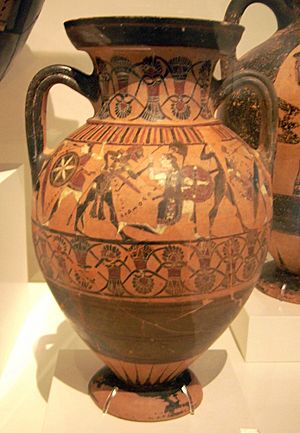Tyrrhenian amphora facts for kids
The Tyrrhenian amphora is a special type of ancient Greek pot. It's a kind of amphora, which is a tall jar with two handles. These amphorae were made in Attica, a region in ancient Greece that included Athens. They are known for their unique black-figure style of painting, where figures are shown in black on a red clay background.
Tyrrhenian amphorae were only made for a short time, from about 565 BC to 550 BC. They have an egg-like shape and often feature eye-catching decorations. The handles usually have designs like lotus flowers, palm leaves, or plant patterns. A red line often marks the end of the handle. The main body of the pot has several decorated bands, called friezes.
The top frieze, on the shoulder of the pot, is usually the most interesting. It often shows scenes from Greek mythology, like stories about gods and heroes. One special scene sometimes seen is the sacrifice of Polyxena. Sometimes, names are written next to the figures to explain who they are. The other two or three friezes below often show animals. Sometimes, a frieze might even be replaced by a band of plant designs.

Why Are They Called Tyrrhenian?
These amphorae are named "Tyrrhenian" because most of them have been found in Etruria, an ancient region in what is now Italy. The Etruscans were a people who lived there long ago. They loved these pots, and many were shipped from Greece to Etruria.
How Were They Made and Sold?
The animal designs and bright colors on Tyrrhenian amphorae look a lot like pots made in Ancient Corinth, another important Greek city. It's thought that pot painters in Athens copied these popular Corinthian styles. They did this to make their own pots more appealing to buyers in Etruria.
By making pots that looked like the popular Corinthian ones, Athenian artists directly competed with Corinth, which was the main seller of pots at the time. Corinth didn't make many neck amphorae, so Athens found a special market for their own versions. The Etruscans even made similar pots themselves.
Early artists who painted these vases include the Castellani Painter and the Goltyr Painter. Later artists were the Prometheus Painter and the Kyllenios Painter. The group of artists who made these pots is called the Tyrrhenian Group, named after this type of vase.
When Were They Made?
In 1983, a British archaeologist named Tom Carpenter suggested that these vases might have been made a bit later than first thought, perhaps between 550 BC and 530 BC. He looked at the pictures and writings on the pots to figure this out. He also wondered if they were made outside of Athens, maybe in northern Attica or even somewhere else entirely.
See also
 In Spanish: Ánforas tirrenas para niños
In Spanish: Ánforas tirrenas para niños

